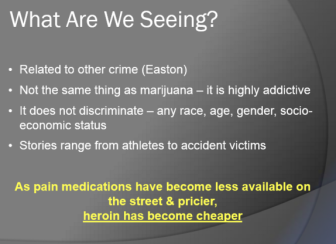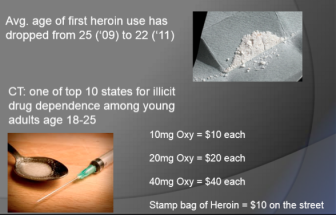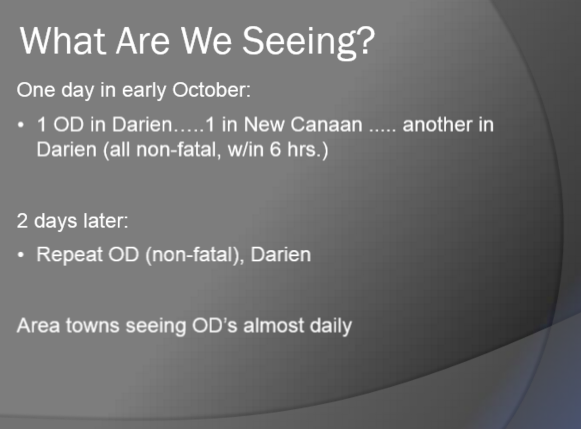A 21-year-old without a pulse. A 19-year-old, eyes rolled back, lying on the side of a road. The same young man had been revived from an overdose two days before. These incidents happened in the past two weeks, police say.
In Darien, according to police, heroin and related painkillers are wrecking lives of addicts and traumatizing their families at a faster pace in the past year, shocking veteran detectives, putting Post 53 teenagers into disturbing scenes and contributing to crimes in town.
That was one of the messages at a panel discussion Thursday in Town Hall on heroin and prescription painkiller abuse.
__________
This article, the first in a series “Heroin in Darien” based on the “Straight Talk-Lifting the Veil: Facing the Hidden Drug Epidemic in Darien” panel discussion, will look at what police are confronted with in dealing with heroin and prescription painkiller abuse in Darien. Future articles this week will present information on how addiction starts and what parents, potential addicts and others can do to prevent it, how addiction is treated and what it’s like to become addicted and to overcome it. Other articles in this series:
- Heroin in Darien 2: Signs of Addiction in Your Kid & How to Reduce the Risk
- Heroin in Darien 3: ‘I’m a Darien Resident in Recovery’
- Heroin in Darien 4: Heroin’s Powerful Addictiveness & How To Break Loose
_________
Drug abuse is so shameful and at the same time so overwhelming for both addicts and families that the addicts deny it and the families can look the other way or otherwise not deal with it effectively, panel members said.

A quote from Stamford Police Capt. Richard Conklin, widely respected among police officers in surrounding departments for his knowledge about drug abuse in the area, according to Darien Police Sgt. T.J. Whyte.
But with widespread abuse of painkillers derived, like heroin, from opium, and falling prices for heroin in recent years and months, the problem has grown. After trying heroin or abusing painkillers, addiction can start in less than a week and be extremely difficult to break, experts on the panel said.
“If your son or daughter had a brain tumor, you’d go far and wide to try to get the best treatment,” Police Sgt. Jeremiah Marron told the audience. “Cost wouldn’t be a consideration, and you would do whatever you needed to do to make sure you got proper care for your son or daughter.
“Yet when we talk about addiction, your first and foremost priority is to make sure the neighbors don’t find out about it. That stigma needs to be changed.”

A slide from Whyte’s presentation
Police Sgt. T.J. Whyte told the audience: “These are just traumatic scenes, especially for our Post 53 kids that are going to these [incidents] and see vomit, blood, syringes. They’re very traumatic, with parents screaming, ‘Help my son!’ ‘Help my daughter!’ […] I signed up to be a police officer to help people, but these are just traumatic scenes.”
At another point, Whyte said: “It’s something that is taking lives and worse — kids and people in our town. The stories range from high school — great athletes, [to] college athletes, to people who were in car accidents, [who] now all of a sudden are hooked on it.”
That may happen when people get addicted to the painkillers they’re prescribed, he and other panel members said. “The thing that scares us: 81 percent of first-time heroin users had used […] prescription pills before,” Whyte said.

Overdose deaths from heroin and Fentanyl (one of the heroin-like prescription painkillers now often sold illegally). Deaths spiked in April and are very high for 2015, police said.
A doctor on the panel, John Douglas of Silver Hill Hospital, later added that most people who are prescribed painkillers don’t get addicted, although many addictions appear to have started with opioid painkillers before addicts found heroin was cheaper.
From 2007 to 2012, heroin use rose 79 percent, nationwide, Whyte said. Marron said police seized 136 units of heroin, “and I can tell you that changed today when I dealt with one individual who we arrested.”
In mid-2014, a Darien police sergeant was told by an official at a nearby hospital that 13 overdose cases had come to nearby hospitals in 2013 from Darien alone.

Crimes directly involving heroin in Connecticut this year.
Darien police knew of none of those overdose cases, and they have since been working with area hospitals to get informed regularly about overdose cases in ways that allow hospitals to conform with federally guaranteed patient privacy rights.
“Area towns have seen overdoses almost on a daily basis, if not multiple [times a day],” Marron said, “and I talked to Stamford officers who are going to two and three a day. This is here folks. It’s in our area.”
There have been 28 deaths in Fairfield County related to heroin and prescription painkiller abuse from January to July 15, Marron and Whyte said. Those deaths include many from urban areas, but also from suburban towns like Darien, they said.
Why heroin and painkiller abuse is up
In recent years, doctors have been prescribing painkillers more frequently, Whyte said. More recently, the federal government has tightened restrictions on the prescriptions, making them harder to get and harder for abusers to get at pharmacies, he said.

Another slide from Whyte’s presentation
But heroin prices have decreased substantially, until it’s at the point where the price is competitive with or lower than prescription opiods bought illegally on the street.
The cost of a prescription opioid is about $1 per milligram (in other words, $5 for a 5 mg pill, $10 for a 10 mg pill). So people already addicted to an opioid high are often turning to heroin.
Marron described several incidents from the past two weeks (omitting names and changing street names for privacy reasons), and Whyte described others in the past two years. Marron read these reports of recent incidents:
Case One: arrested with heroin and a gun
Marron described one incident that occurred on the very day of the forum, in which investigators gathered up enough information to arrest a Darien man, who was then pulled over as he was driving.
“The subject was found with 30 hypodermic needles on him, a small quantity of heroin and a firearm,” Marron related.
“Based on that, we secured a search warrant for his residence and we seized […] firearms. This is a Darien resident. That happened today. This is what we’re facing. I’ll let you make the call on whether or not we have a drug problem in Darien.” Police seized 67 firearms, belonging either to the arrested man or his father. More information on the case is here.
Case Two: overdose at home
“Officer [Christopher] Jimenez and I were dispatched in reference to a subject who was unconscious and possibly overdosed. Upon arrival, we were let in the residence and were directed to the living room. In the living room we located the 21-year-old male victim who was lying on the floor and was unconscious. The victim was blue and had no pulse.
“Officer Jimenez began chest compressions while I applied the AED [a medical device that can deliver an electric shock to get a heart pumping again]. The AED advised no shock. [The device, once connected to the body, will advise whether or not a shock should be administered.]
“I began CPR [cardiopulmonary resuscitation]. The victim remained unresponsive throughout the resuscitative efforts. According to the family, they believe some type of opiate was responsible for today’s incident. It should be noted that the victim overdosed in the summer of 2014. He was transported to Norwalk Hospital.”
Case Three: at Darien EMS-Post 53
“Officer [Michael] DosSantos and I were dispatched to Post 53 for a report of a male who was unconscious. Upon arrival, the patient was being treated in the ambulance. A […] male […] was conscious at the time […] [A friend of the victim [who] brought him to Post 53 said he appeared to be experiencing a heroin overdose.]
“As the victim was being treated in the ambulance, EMS [Emergency Medical Services] personnel discovered a small bundle of folded papers inside the victim’s right front pocket. The suspicious substance [in the papers] tested positive as heroin.
“The victim’s friend told EMS personnel that he took the victim to Post 53 because he was found unconscious in his own vehicle, which was parked outside of his residence.”
_____________
See also:
- Police Chief: Heroin Use is Up in Darien, What Parents Can Do (Oct. 22)
- Police: Darien Driver Found with Heroin, Guns Confiscated (for Now) (Nov. 9)
- Police Now Will Administer Life-Saving Naloxone for Heroin Overdoses (Nov. 15)
_____________
Marron later said, not necessarily connected to this particular case: “We’re noticing something a little unusual […] We’re coming across this ‘buddy system’ where someone will use heroin with a friend […] a buddy who is instructed to Dial 911 so they know Narcan [a medication that can reverse the effects of a heroin overdose] is minutes away and can possibly bring them back and save them.”
(More details about this incident are related below.)
Case Four: on the side of a road
“Upon arrival, I observed the victim, who was determined to be a 19-year-old Darien male resident. The victim was being treated by members of Darien EMS [Post 53].
“The victim appeared to have labored breathing, was unresponsive to stimuli and his eyes were rolled back in his head. A neighbor reported that the victim had been babysitting her kids hours earlier.
“The victim’s father arrived on scene and advised that his son was prescribed medications for several reasons.” He was then transported to the hospital and treated for a possible overdose.
During the question-and-answer period of the meeting, a woman who said she is a Darien EMS-Post 53 adult volunteer spoke about this incident and the previous one mentioned above. She said she knew the doctor on the panel and some of the other panel members, and no one contradicted her.
She said a call came in at Post 53 instead of to 911. “His friend — who said [at first] he wasn’t his friend — called Post […] and said ‘I have someone, and I’m bringing him in.’
“The young person who answered the call said, ‘You need to make a 911 call.’ The guy said he wasn’t going to call, he was bringing him in. […]
“The patient is on the passenger side like a rag doll. As a matter of fact, somebody went to open the passenger-side door and I pushed it shut, knowing that he would just flop out. […] We quickly got him on a gurney. […] He had white substance around his nose. He had blood on his nosed. His friend said, ‘I think he overdosed.’
“He did have a pulse, though he was blue around the mouth and floppy as a rag doll,” she said. “I administered Narcan up his nose, once in each nostril, and — probably in 30 seconds, although it seemed like infinity — he woke up and he was as coherent when he awakened, nearly, as I am now. He’s fortunate.”
Two nights later, she went on an ambulance call (the last incident related by Marron just above) for an overdose and saw the same victim.
“My co-worker had already administered the Narcan. The patient woke up, sat up on the gurney, looked me dead in the eye and remembered me from two days before, and he said, ‘Thank-you’ and ‘I’m sorry,’ and I knew he meant both. I said, ‘Do you want to live?’ and he said ‘Yes,’ and I believe him.
“And he said he was sorry because on the first call, when I heard he was behind the wheel, it upset me greatly, so I couldn’t help myself […] I did say to him, ‘Thanks a lot, because I’m driving around town with a car full of kids. How dare you.'”
Behind the headlines
Whyte read some newspaper headlines and added some information about each case:
- “Cops: Man Made Heroin Sales Near Daycare” (Darien News, April 2014) — “This man was a member of the Crips gang, from Norwalk.”
- “Darien Police Arrest Two in Heroin Bust” (Darien Times, August 2015) — “One of those two was shot multiple times a few days later in Bridgeport.”
- “Wiretap nets Stamford’s Most Violent” (Stamford Advocate, September 2015) — “Including three of our own Darien youth in that same wiretap.”
- Whyte also added that in the recent murder of an Easton couple, their son, who was arrested for the crime, is alleged to have a heroin addiction and was in a conflict with his father.
Additional things police are doing to address the problem
Marron said that in the Fall of 2013, “I and other fellow officers proposed to police administration that we start a narcotics unit. For departments our size, that’s kind of nontraditional, but the administration agreed with us and recognized the importance of it, based on the problem we were facing, and [we] started up, part time, what we called a ‘Selective Enforcement Unit.’
“Two years later, we’re 14 members strong. In fact, we have a couple officers […] who are assigned to it full time at this point. You could basically call us the Prescription Narotic Abuse and Heroin Unit at this point.”
Whyte said Darien police are sharing more information about drug selling with other law enforcement agencies and training on the use of Narcan.
Pawning valuables stolen from home
Every day, Marron said, a Darien police detective is assigned to look over reports from area pawn shops about what’s been pawned and by whom.
“I can’t tell you how many times that we see a local kid’s name who’s pawning high school rings, their parents’ silverware, wedding presents, and we go and knock on the door because we recognize the red flags.
“And we tell them, ‘Hey, do you know Johnny just pawned a 1964 Stamford High School ring?’
“‘No officer, it’s upstairs in our bedroom.’
“‘Please go check’ […] Then they realize all the things missing, and that’s the first time that they know that their son has a problem.
“Every single day in Darien,” Marron continued, “we are responding to incidents that are somehow connected to the narcotics problem in town, and in nearby communities, whether it be domestic violence, DWIs, larcenies, car burglaries, home burglaries, and, obviously, overdoses.”
Police don’t believe the heroin problem can be solved just by making more arrests. Future articles will relate what experts say parents can do, how addicts are treated and what a recovered addict says about his experiences.
See the full video of the panel discussion on Darien TV79:
The Hidden Drug Epidemic – Depot 11-5-15 from Darien TV79 on Vimeo.
___________
Correction: Sgt. Marron has changed his description of the Thursday arrest of a man in a pickup truck found with heroin and a long rifle. On Monday Marron said he is no longer asserting that the man was going to trade the gun for heroin from a drug dealer. Police now say the number of guns seized from the man’s car and home is 67, not 55.
Editor’s note: Minor editing for clarity and removing typographical errors in this article was done at 8:38 p.m.


Pingback: Police: Darien Driver Found with Heroin, Guns Confiscated (for Now) | Darienite
Pingback: Heroin in Darien: Signs of Addiction in Your Kid & How to Reduce the Risk | Darienite
Pingback: Heroin in Darien: Signs of Addiction in Your Kid & How to Reduce the Risk | Darienite
Pingback: Heroin in Darien 3: ‘I’m a Darien Resident in Recovery’ | Darienite
Pingback: Police Now Will Administer Life-Saving Naloxone for Heroin Overdoses | Darienite
Pingback: Heroin in Darien 4: Heroin’s Powerful Addictiveness & How To Break Loose | Darienite
Pingback: Stevenson Discusses Opioid Painkiller Addiction at Breakfast with Legislators | Darienite
Pingback: Police: We Can't Arrest Our Way Out of Drug Addiction in Darien - DarieniteDarienite
Pingback: My Homepage